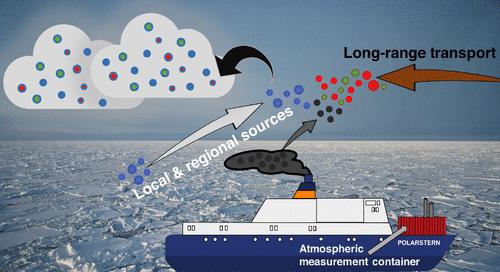Sources and Composition of Organic Aerosols in the Central Arctic during Spring and Summer
IF 11.3
1区 环境科学与生态学
Q1 ENGINEERING, ENVIRONMENTAL
引用次数: 0
Abstract
Organic aerosols (OA) are a major component of Arctic aerosol mass and influence the region’s radiation budget, yet their sources and physicochemical properties remain largely unknown. We investigate OA sources and climate-relevant characteristics over the central Arctic Ocean in spring and summer, by applying positive matrix factorization to aerosol mass spectrometry data from two ship-based expeditions (2018 and 2020), complemented by total and interstitial aerosol measurements during fog periods. Six distinct OA factors were identified: haze-related OA, Arctic oxygenated OA, two mixed-OA types resembling biomass burning and primary marine OA linked to warm-air intrusions, marine OA, and hydrocarbon-related OA. Seasonal transitions strongly shaped OA composition. Following polar sunrise, highly oxygenated OA, likely formed secondarily from photo-oxidized volatile organic compounds, became dominant. After the polar vortex collapsed in May, episodic spikes in marine OA from the marginal ice zone appeared, alongside a reduced influence from Eurasian anthropogenic sources. These transitions influenced OA oxidation state and related properties including volatility, acidity, and hygroscopicity, highlighting the role of the Arctic spring atmosphere as an active photochemical reactor. Overall, OA was highly oxidized, with particles activated in fog during summer showing even greater oxidation, suggesting that central Arctic OA can be highly cloud active.

春夏季北极中部有机气溶胶的来源和组成
有机气溶胶(OA)是北极气溶胶质量的主要组成部分,并影响该地区的辐射收支,但其来源和物理化学性质在很大程度上仍然未知。本文通过对2018年和2020年两次船载考察的气溶胶质谱数据进行正矩阵分解,并辅以雾期总气溶胶和间隙气溶胶测量,研究了北冰洋中部春季和夏季OA来源和气候相关特征。确定了六种不同的OA因素:雾霾相关OA、北极氧合OA、两种类似生物质燃烧的混合OA类型、与暖空气入侵相关的初级海洋OA、海洋OA和碳氢化合物相关OA。季节变化强烈地影响了OA组成。在极地日出之后,可能由光氧化挥发性有机化合物次生形成的高氧OA占主导地位。极地涡旋于5月崩溃后,边缘冰带的海洋OA出现了间歇性峰值,同时欧亚人为来源的影响也有所减弱。这些转变影响了OA氧化态和相关性质,包括挥发性、酸度和吸湿性,突出了北极春季大气作为活跃光化学反应器的作用。总的来说,OA是高度氧化的,夏季雾中活化的颗粒显示出更大的氧化,这表明北极中部的OA可能是高度活跃的云。
本文章由计算机程序翻译,如有差异,请以英文原文为准。
求助全文
约1分钟内获得全文
求助全文
来源期刊

环境科学与技术
环境科学-工程:环境
CiteScore
17.50
自引率
9.60%
发文量
12359
审稿时长
2.8 months
期刊介绍:
Environmental Science & Technology (ES&T) is a co-sponsored academic and technical magazine by the Hubei Provincial Environmental Protection Bureau and the Hubei Provincial Academy of Environmental Sciences.
Environmental Science & Technology (ES&T) holds the status of Chinese core journals, scientific papers source journals of China, Chinese Science Citation Database source journals, and Chinese Academic Journal Comprehensive Evaluation Database source journals. This publication focuses on the academic field of environmental protection, featuring articles related to environmental protection and technical advancements.
 求助内容:
求助内容: 应助结果提醒方式:
应助结果提醒方式:


